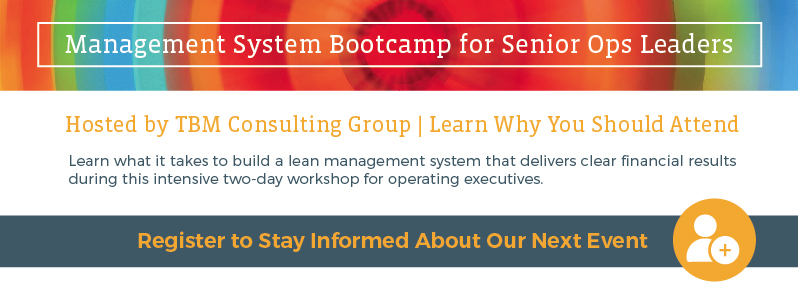Leadership “support” is not sufficient.
Executives often tell us that they are frustrated by both the speed and impact of their lean manufacturing initiatives. They fully endorse everything that their CI teams are doing to eliminate waste, establish flow, speed throughput, improve quality and productivity, and reduce costs. Why then, they ask, aren’t their investments in continuous improvement, employee development and external support having a measurable impact on what matters most? That is: Financial performance and profits.
John Wynne and I recently wrapped up a TBM management briefing that answers that question. As we explain, you can adopt lean methodologies, but you won’t see the sustained, long-term, financial benefits without embracing the management practices that support them. In the briefing we explain how an effective operational management system and the right management practices and behavior can create a high performance culture.
Making the transition is where companies struggle. In the management briefing we explain how to do that, including a step-by-step example of how we are helping one company change how its managers and supervisors think and act. Here’s a peek at some of our thinking in the full report.
Management Behavior and Priorities Define Your Culture
Manufacturers often struggle after the first stage of their lean implementation. They have successfully streamlined material flow and made some highly visible changes on the plant floor. They have made significant efficiency improvements. Despite these successes, they often don’t see a major impact on the company’s financial performance.
Such returns can fail to materialize for a variety of reasons, of course. But the underlying cause in most cases is that, while companies have changed how material flows, they have not changed how the business is managed on a day-to-day level.
Management practices continue to follow a traditional, hierarchical approach that emphasizes control. In such a structure managers are the go-to decision makers and problem solvers. Problem-solving, customer responsiveness and the pace of improvement are therefore limited by managers’ capacity and availability.
As we explain in the management briefing, the traditional management structure and culture is different from a lean management system in many key aspects. Here’s a quick look of some of those differences:
| Traditional Management Culture | Lean Management System | |
Improvement Projects | Not completed on time. Frequently fall short of anticipated returns. | Issues are addressed in early stages without necessitating a special project. Projects are completed quickly and hit or exceed targets. |
| Problem Solving | Potential solutions take a long time to identify and implement, and the same issues keep creeping up over and over again. | Employees habitually seek out root causes. Management and supervisor monitoring ensure that problems do not recur. |
| Process Changes and Performance Gains | Not sustained, constant struggles to maintain baseline performance. | Progress is sustained, and built upon. |
Continuous Improvement ROI | No significant impact on the business unit or the company's financial performance. | Measureable and meaningful impact on margins, profits and revenue growth. |
You Can Get There from Here
You’ve probably heard or read about the coaching-oriented behavior and practices at the core of a lean management system. What operations leaders don’t understand is how to efficiently adopt such practices, especially across a large and dispersed company.
In short, changing daily management behavior requires a clear understanding of the desired practices coupled with regular progress assessments and coaching. TBM conducts many of these assessments for our clients on a less or more formal basis. In the management briefing, we describe the diagnostic matrix that we use to evaluate and rate management practices at each level.
The key point to understand here is that changing from traditional management practices to a lean management system will not happen without guidance and deliberate practice. I wish I could say that it’s easy, but it’s not. Business leaders have to understand and demonstrate the practices and behaviors required to make the transition. Only then will the organization’s problem-solving capabilities accelerate sufficiently across the organization to have a measurable impact on financial performance and profits.
New Management System Bootcamp for Senior Ops Leaders
If your investment in continuous improvement isn't generating significant and sustainable growth for your business, then it may be time to assess where you are and to give some thought to what's required to get it back on track. At this two-day intensive Management System Bootcamp, you'll learn why your management system isn't working the way you need it to. And, you'll discover how to get it into its best shape ever to quickly deliver impact to the business.




